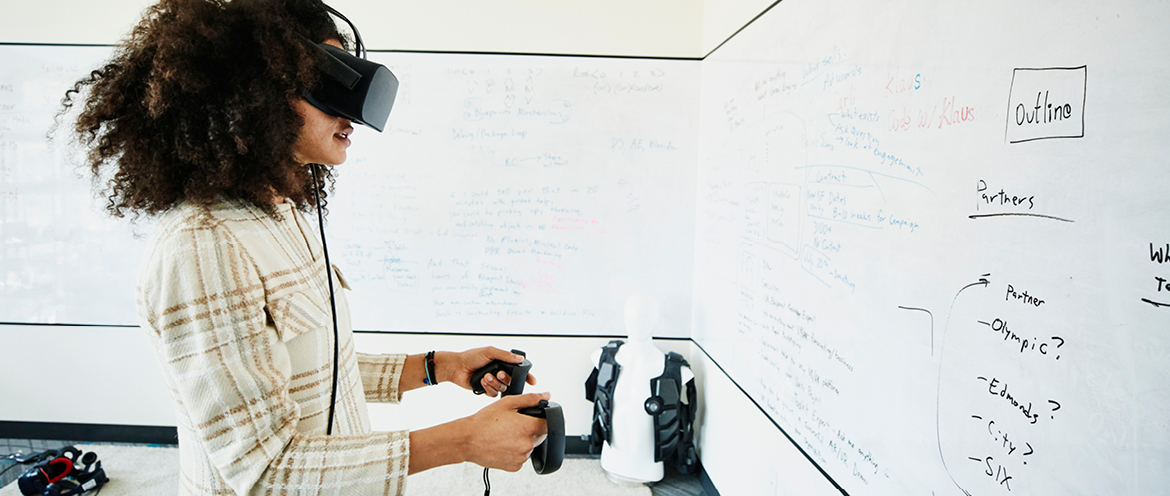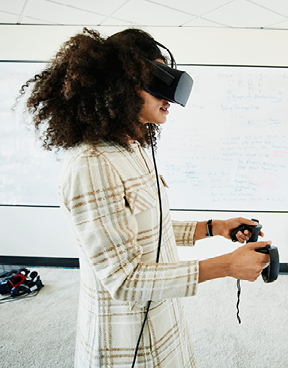Five Ways VR and AR are Transforming Student Learning Experiences in Higher Education


Virtual reality (VR) and augmented reality (AR) technology once seemed like something out of a science-fiction movie. Now, they’ve become more common than ever, including in academic environments.
Workforce Edge education partners strive to offer students diverse learning opportunities they can apply in real-world settings. Engaging with VR and AR technology gives students practical experiences that they may not otherwise have access to until later in their careers. This helps better prepare students for their chosen professions or fields.
Read on to discover five ways colleges and universities are using VR and AR to enhance educational experiences for students.
1. Research
Students across the country are participating in research studies involving VR technology.
X. Simon Wang, PhD, associate professor of medicinal chemistry in the department of pharmaceutical sciences at the Howard University College of Pharmacy, is one professor leading research involving VR and AR technology. Through several years of experimentation, Wang, his colleagues, and student researchers have developed an immersive learning environment that allows learners to experience clinical scenarios virtually.
“VR is changing higher education in very fundamental ways,” Wang says. The current VR teaching videos Wang and his team have developed are of 4K UHD quality, enabling the student to see a 360-degree view of the clinical demonstration with a special headset at home. Videos are also viewable on a computer or mobile device.
“Our VR-teaching platform provides alternative means of access to multimedia content in formats that meet the needs of diverse learners, thus promoting the achievement of the learning objectives,” Wang says.
2. Lab experiences
When students have access to VR and AR technology, they can engage with lab materials in an immersive way. Tracy B. White, program director of radiation therapy at Arkansas State University – Jonesboro, says that using a VR tool called VERT has made her students even more engaged with their radiotherapy coursework.
“Many students are kinetic learners,” White says. “The technology keeps them interested.”
The benefits of using VERT include visualizing and interacting with 3D structures, experiencing a safe, low-pressure environment to practice skills, and building decision-making skills.
“In the VR lab, you can ask questions that you just can’t ask in front of a patient,” White says. “You can dissect the subject and look inside, which you obviously can’t do in real life, and you can see how the organs are affected by the tumors.”
White believes that when it comes to health care education, students can never get too much experience before going into the clinic. With the virtual component plus the human component, White believes she is able to increase her students’ chances of successfully preparing for clinical work.
“We’re going to need more health professionals than ever in the coming years,” White says. “With baby boomers getting older, we will need to pull more interested students into the field. We’ve used our VR technology as a recruiting tool. It gets students excited.”
3. Distance learning
Students enrolling in an online degree program may wonder if they’ll get the same kind of hands-on experiences as their in-person peers. Because of VR technology, students can participate in lab experiences that mirror a real-world setting virtually.
Theory and practical application come together in simulated chemistry labs, patient interactions, and even virtual procedures or surgeries. The costs involved in obtaining a VR headset are consistently decreasing. White says that a headset now costs less than some traditional textbooks.
4. Campus tours
With the onset of the COVID-19 pandemic, universities across the globe had to pivot and find a way to share the campus experience with students who could no longer visit campus. Now, campuses increasingly offer VR tours to supplement their in-person experiences.
It used to be that a student interested in attending a university 2,000 miles away would have to make a long trip to tour the campus. Those who couldn’t make the trip would have to show up on the first day of classes and hope they made the right choice. Not anymore.
With VR campus tours, prospective students can experience the feeling of strolling down the quad or exploring academic buildings without ever setting foot on campus.
5. Healthcare, business, architecture, programming, and more
At Butler University, a graduate donated $1 million to the construction of the Esports Park, a multiuse esports and technology facility. The space, which opened in August 2022, features virtual reality technology that is integrated into the holistic academic environment. A minor in Esports communication was recently added to Butler’s curriculum, which allows students to gain skills in esports production, communication, business, and more.
The University of Tennessee, Knoxville, is one of the first universities to offer a class that regularly takes place in a virtual reality format. The subject? Marketing. Distinguished lecturer of marketing, Mark Collins, taught a segment of the capstone marketing course in a virtual reality classroom. Students attended using VR headsets and existed in the virtual space as avatars. Collins says that the interaction and engagement by the students in the VR classroom was night and day compared with meeting only on Zoom.
Students taking the next step in their educational journeys will begin to encounter VR and AR technology more and more, especially within distance learning and online programs. This exposure will allow students to stay on the cutting edge of technology as they grow their skills and prepare to launch the next stage of their careers.
For employers, it’s important to expand access to educational opportunities to their teams. This can be especially true when it comes to academic programs that incorporate VR and AR content. By supporting employees with these education benefits, companies can attract and retain talent – talent that is motivated to learn, grow and contribute.
Learn more about partner universities through Workforce Edge here.
Virtual reality (VR) and augmented reality (AR) technology once seemed like something out of a science-fiction movie. Now, they’ve become more common than ever, including in academic environments.